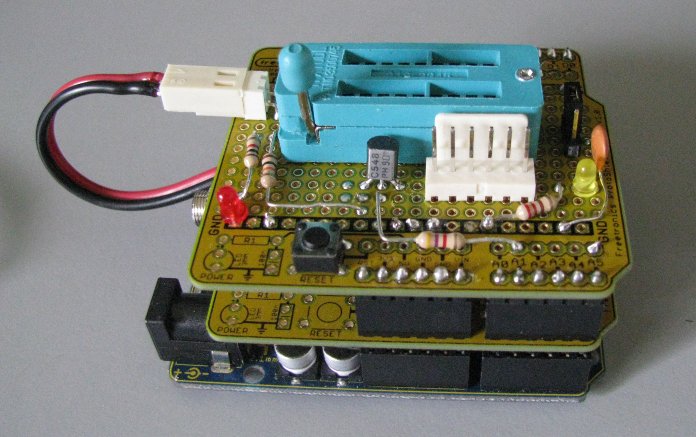

I thought i would add a few tips for those like me who are newbies. I built the circuit on a protoboard and have tested it with a 28C64 and with a little bit of re wiring also reading a 27C64. external 5V and GND powersupply lines (also on the 20-pin port)īeside the Java GUI Tool another guy from the forum is working on python based command line tools that can be used with the programmer.20 pin - port with all data, address, RX/TX and control lines for direct access with any other hardware.
EEPROM PROGRAMMER RS232 SERIAL
DIP-switches / jumpers for setting the speed of the serial connection. MAX232 and DSUB9 connector for RS232 communication without the Arduino USB. The plan is to build a PCB at the end with some additional features GUI after writing the ROM image to the EEPROM and then making a diff again. GUI after making a diff between the cleared EEPROM and the loaded 8k ROM image, showing all 8192 bytes as different: GUI after start, selecting different EEPROM types, getting Version String, clearing EEPROM and loading a 8k ROM image: Here's a short collection of screenshots from the GUI: Fairly fast enough to meet my requirements for a good development life-cycle for the 6502 firmware that should be stored on the EEPROMS. An 8k EEPROM can be written within 8 seconds. On the Arduino side I use an 1024 byte buffer to store the data bytes before they are written to the eeprom. doing "differential" writes (writing only bytes that are different between ROM image and EEPROM) split large ROM images for burning several small EEPROMS with the complete data write only parts of the eeprom instead of the whole chip (from address to address) Import and Export data in Intel-HEX format get the Version Sting from the MEEPROMMER. count number of different bytes between internal rom image and data on EEPROM.  read hex data from EEPROM (directly written to console window for testing). load data from EEPROM binary to internal buffer. select EEPROM type (8k,16k,32k) (has influence on the number of bytes read/written). Load ROM-Files (max 32k) into the application. Provide "Version String" with supported commands. At the moment the following features are implemented: I also wrote a small Java GUI that interacts with my little programmer. The "firmware" on the Nano excepts and delivers data through a serial connection to the host computer, using a simple protocol for sending and reading data from and to the EEPROM. So the Nano can be removed and used for other projects. The Nano is stacked on a 600mil DIP socket, that I cut down to 30 pins. Here is a picture of the prototype with the Nano V3, 2 74HC595 and a ZIF socket for the EEPROM. But unfortunately I need pin 0 and 1 for RX/TX, making it a little bit harder to set 8 data bits for the EEPROM. The only internal PORT of the Atmeg328 on the Nano that can be completely used with 8 data bits is PORTD (digital Pins 0 to 7).
read hex data from EEPROM (directly written to console window for testing). load data from EEPROM binary to internal buffer. select EEPROM type (8k,16k,32k) (has influence on the number of bytes read/written). Load ROM-Files (max 32k) into the application. Provide "Version String" with supported commands. At the moment the following features are implemented: I also wrote a small Java GUI that interacts with my little programmer. The "firmware" on the Nano excepts and delivers data through a serial connection to the host computer, using a simple protocol for sending and reading data from and to the EEPROM. So the Nano can be removed and used for other projects. The Nano is stacked on a 600mil DIP socket, that I cut down to 30 pins. Here is a picture of the prototype with the Nano V3, 2 74HC595 and a ZIF socket for the EEPROM. But unfortunately I need pin 0 and 1 for RX/TX, making it a little bit harder to set 8 data bits for the EEPROM. The only internal PORT of the Atmeg328 on the Nano that can be completely used with 8 data bits is PORTD (digital Pins 0 to 7). 
But the address lines are only needed as output, so I decided to use 2 74HC595 shift registers to reduce the needed I/O pins from 15 to 3. The whole thing is based on an Arduino Nano, because of the small form factor, the good price and (very important) and already available serial connection via USB.įor 15 address lines, 8 data lines and 3 control lines I need 26 I/O pins, too much for the Nano. You can buy a programmer, but they are too expensive for just a simple project. Additionally some control lines like /WRITE, /OUTPUT and /ENABLE need to be connected to the EEPROMs. These chips are parallel memory chips with a 13 to 15 bit wide address bus and a 8 bit databus.

For my upcoming 6502 CPU based homebrew computer project I need the possibility to program EPROMs and EEPROMs.








 0 kommentar(er)
0 kommentar(er)
